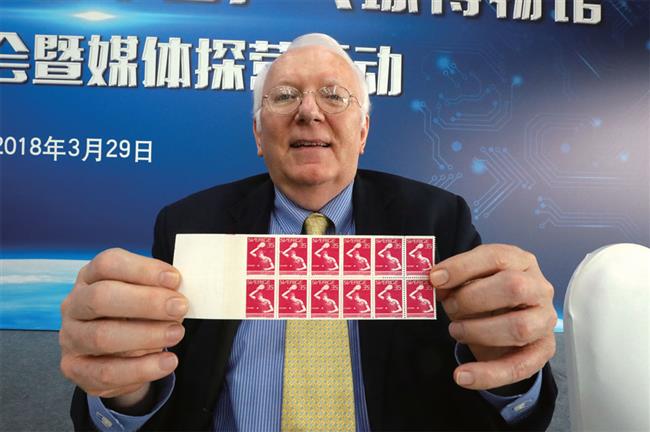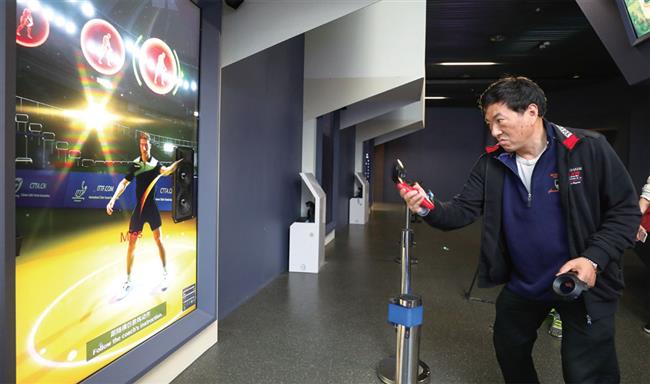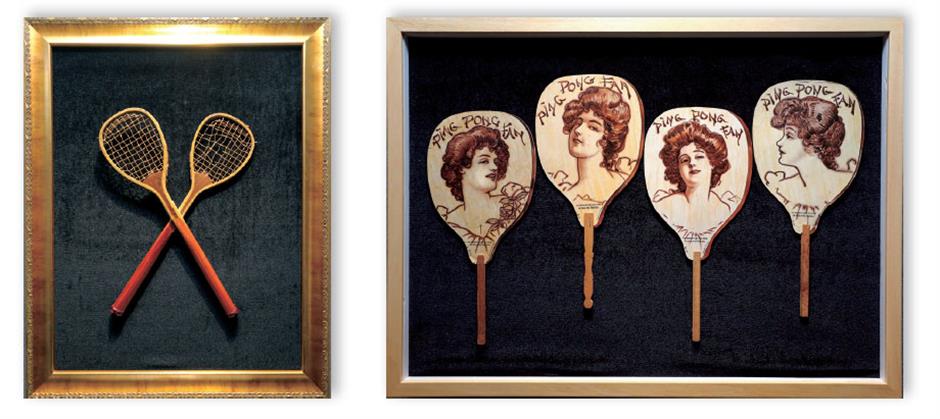
Chuck Hoey, former curator of International Table Tennis Federation Museum in Lausanne, Switzerland, shows stamps issued by Sweden related to the sport.
THE International Table Tennis Federation Museum and China Table Tennis Museum will open in Shanghai tomorrow.
It is China’s first world-class sports museum and is located at 796 Jumen Rd — next to the World Expo Museum in Huangpu District.
The ITTF Museum was previously in Lausanne, Switzerland, where the International Table Tennis Federation is based.
The museum in Switzerland had collected more than 8,000 items related to the sport, while keeping a record of the history of the sport.
“But the interest in Switzerland was not great ... only a few thousand visitors,” said Chuck Hoey, former curator of the ITTF Museum.
Due to limited visitors to the museum in Lausanne and China’s contributions to the development of table tennis, the ITTF decided in 2014 to move the museum to Shanghai, which was planning the China Table Tennis Museum around the same time.
The government then decided to put the two museums in one building.
The project, managed by the Shanghai University of Sport, started on July 22, 2016 and was completed on February 5 this year.
Taking up 5,000 square meter of floor area and a total construction area of 10,389 square meters, the museum is spread over four floors including the basement.
It is divided into several sections — exhibition, public services, interactive, collection and research.
The exhibition zone showcases international and Chinese table tennis culture, and has an area reserved for the sport’s heros.
 Jiang Xiaowei / SHINE
Jiang Xiaowei / SHINEA man tests his table tennis playing skills with multi-media interactive technology at the museum.
The international area has more than 8,000 exhibits, including the history of the sport, its origin in UK, the development of rackets, balls and other sporting equipment.
These include the Foster Set, the first set of table, net, rackets and balls for the sport produced in 1890 in the UK.
Another pair of wood rackets and original oil paintings of a man and a woman playing table tennis — items collected by Hoey, who spent almost 10 years trying to persuade the collector to give it to the museum.
Visitors will also get to see the world’s first pair of table tennis rackets shaped like those used in tennis now but in smaller size, the first ball made of rubber and the tools used by British ladies to pick up the balls from the floor.
Another section will profile players who have won at least five world championships.
The China section has more than 3,000 exhibits that throw light on how the sport was introduced in China around 1901 and developed into a national sport. There is a postcard which was sent by a German in Tianjin to a friend in Belgium in 1902, saying that he saw almost all European families in Tianjin playing table tennis.
A racket painted with the images of Chairman Mao Zedong and former US President Richard Nixon is also part of the exhibit. Their meeting popularized the term pingpong diplomacy.
Items belonging to famous Chinese players such as Deng Yaping’s T-shirt and a pair of sneakers worn by Zhang Jike are on display.
In the interactive section, visitors can horn their pingpong skills by imitating the movements on the screens, or play against world champions via VR or against robots.
 Jiang Xiaowei / SHINE
Jiang Xiaowei / SHINEA paddle with pictures of Chairman Mao Zedong and former US president Richard Nixon highlighting the Sino-US pingpong diplomacy in the early 1970s.
Hoey, who spent over 40 years collecting items related to the sport across the world, is glad to see the museum move from 10 rooms in an old chateau in Lausanne to the three-floor building in Shanghai.
He said Shanghai was the best location to give a new life to the museum. “China is where the sport is loved and which has a great and long tradition of success by their athletes,” he said. “Many more people can enjoy the museum in China, and my expectations are very high.”
Vice Director of the General Administration of Sport of China and Chairman of the Chinese Table Tennis Association Cai Zhenhua, the women’s world champion Zhang Yining and ITTF President Thomas Weikert will be present at the opening ceremony tomorrow.
The museum will officially open to the public for free from 1:30pm the same day.
It will be open from 9am to 5pm from Tuesdays to Sundays and on all national holidays.
Visitors to the museum can book their tickets online from its website or WeChat, or call 021-65506650. They can also queue at the museum but will need their ID or student cards.
Chen Peijie, president of the Shanghai University of Sport, said the museum will not only be an exhibition venue, but will also serve as an archive for ITTF, a research base for technique development and an education site for young players.
 Jiang Xiaowei / SHINE
Jiang Xiaowei / SHINELeft: Table tennis bats made in 1890. Right: Fans shaped like table tennis rackets in the early part of 20th century when the sport was popular in the western countries.

TO GO
Address: 796 Jumen Road, Huangpu District.
Open hours: 9am to 5pm, with last admissions at 4pm, Tuesdays through Sundays; 1:30pm to 5pm on Saturday
Tickets: Visitors can book tickets, which are free, from the museum’s WeChat account, or simply call 021-65506650. They will need ID cards if they queue up at the site
